The Ophiuchus constellation, often overlooked and surrounded by mystery, is a fascinating area of the night sky that has captivated stargazers and astronomers for centuries. This celestial region features a unique mythology, interesting stellar features, and remarkable observational opportunities. In this comprehensive guide, we will delve into the enchanting world of Ophiuchus, exploring its mythology, position in the night sky, major stars, and notable features. Stargazers will also discover the best times to observe Ophiuchus, tips for locating it in the celestial sphere, and the equipment and techniques needed to fully appreciate its wonders. Additionally, we will explore the cultural significance and mythological connections of Ophiuchus, as well as its controversial astrological significance. So, grab your telescopes and join us on an extraordinary journey through the fascinating realm of the Ophiuchus constellation.
Contents
- Overview of the Ophiuchus Constellation
- Features of the Ophiuchus Constellation
- Observational Points for Stargazers
- Mythological Connections and Cultural Significance
- The Future of Ophiuchus
- Conclusion
-
Frequently Asked Questions
- What does Ophiuchus represent in mythology?
- When is the best time to observe Ophiuchus?
- Are there any notable double stars in Ophiuchus?
- What are some deep sky objects in Ophiuchus?
- Is Ophiuchus part of the zodiac?
- How can I locate Ophiuchus in the night sky?
- What equipment do I need to observe Ophiuchus?
- What is the mythological connection of Ophiuchus to Greek and Roman culture?
- Can I see Ophiuchus from both hemispheres?
- Is Ophiuchus linked to any astrological relationship compatibility?
- References
-
Frequently Asked Questions
- 1. Can Ophiuchus be seen with the naked eye?
- 2. What is the best time to observe Ophiuchus?
- 3. How can I locate Ophiuchus in the night sky?
- 4. What are the major stars in the Ophiuchus constellation?
- 5. Can I observe nebulae and deep sky objects in Ophiuchus?
- 6. What is the mythology behind the Ophiuchus constellation?
- 7. How is Ophiuchus connected to astrology?
- 8. Are there any notable double stars in Ophiuchus?
- 9. What equipment do I need to observe Ophiuchus?
- 10. Is there any cultural significance associated with Ophiuchus?
- References
- Read More
Overview of the Ophiuchus Constellation
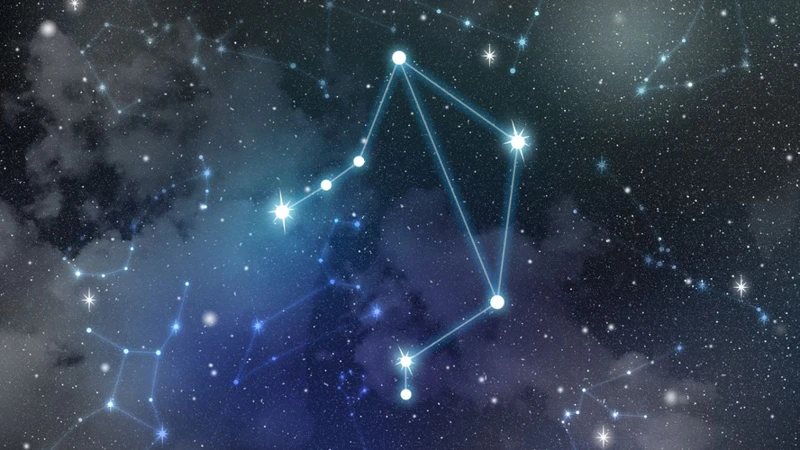
The Ophiuchus constellation, with its intriguing mythology and celestial wonders, holds a significant place in the night sky. Legend has it that Ophiuchus represents a healer, depicted as a man grasping a serpent, symbolizing the pursuit of knowledge and wisdom. Located near the celestial equator, Ophiuchus is visible from both hemispheres during different times of the year. Its position between the constellations of Sagittarius and Scorpius makes it easily recognizable. Ophiuchus is home to several prominent stars, including Alpha Ophiuchi, also known as Rasalhague, and Sabik, forming the head of the serpent held by Ophiuchus. This constellation also holds the mysterious Barnard’s Star, one of the closest known stars to our solar system. Additionally, Ophiuchus is adorned with beautiful nebulae and deep sky objects, making it a delightful treat for astronomers of all levels. So, let us embark on a cosmic journey as we explore the intriguing features and observational points of this enigmatic constellation.
The Mythology behind Ophiuchus
The mythology behind Ophiuchus is deeply rooted in ancient tales and legends. In Greek mythology, Ophiuchus is often associated with the figure of Asclepius, the renowned healer and son of Apollo. Legend has it that Asclepius possessed immense healing capabilities and was even able to bring the dead back to life. This ability caused unrest among the gods, and Zeus, fearing the imbalance it could bring to the world, decided to strike Asclepius with a lightning bolt, resulting in his death. To honor his noble deeds and exceptional healing skills, Zeus immortalized Asclepius by placing him in the stars as the constellation Ophiuchus. Ophiuchus is also associated with the Babylonian hero Gilgamesh, who is said to have searched for the secret of immortality. The serpent held by Ophiuchus symbolizes the rejuvenating properties of the healing arts. Through its mythological connections, Ophiuchus represents the pursuit of knowledge, wisdom, and the delicate balance between life and death. Its presence in the night sky serves as a reminder of the ancient fascination with the power of healing and the mysteries of the cosmos.
Position and Visibility in the Night Sky
The position and visibility of the Ophiuchus constellation in the night sky make it a captivating sight for stargazers. Located near the celestial equator, Ophiuchus can be observed from both the northern and southern hemispheres, although the optimal visibility may vary depending on the observer’s location. In the northern hemisphere, Ophiuchus is best seen during the summer months, reaching its highest point in the sky in July. Meanwhile, in the southern hemisphere, Ophiuchus is more prominent during the winter months, with its peak visibility occurring in December. Due to its position between the constellations of Sagittarius and Scorpius, Ophiuchus is easily identifiable. To locate it, one can draw an imaginary line from the bright star Antares in Scorpius to the teapot-shaped asterism of Sagittarius. Ophiuchus lies in the middle of this line. Its distinctive shape, resembling a man holding a serpent, further aids its recognition. Whether you’re in the northern or southern hemisphere, Ophiuchus offers a stunning celestial spectacle that will surely leave stargazers in awe of its unique presence in the night sky.
Shape and Major Stars
The Ophiuchus constellation, with its distinct shape and notable stars, is a captivating sight in the night sky. The constellation is often described as resembling a stick figure or a man holding a serpent. It stretches across the celestial sphere, spanning approximately 948 square degrees.
One of the major stars in Ophiuchus is Alpha Ophiuchi, also known as Rasalhague. This bright star, located near the head of the constellation, is a binary star system consisting of a white giant and a fainter companion star. It is one of the brightest stars in Ophiuchus and holds significant importance in ancient mythology.
Another significant star in Ophiuchus is Sabik, located near Rasalhague. Sabik is a binary star, composed of two stars that orbit around a common center of mass. This star system emits a bright white light and adds to the grandeur of Ophiuchus.
In addition to these major stars, Ophiuchus is home to several other notable stars, such as Cebalrai, Yed Prior, and Yed Posterior. These stars, although not as famous as Rasalhague and Sabik, contribute to the overall beauty and charm of the constellation.
The unique shape and prominent stars of Ophiuchus make it an easily recognizable constellation in the night sky. Whether viewed through the naked eye or a telescope, the celestial wonders of Ophiuchus never fail to captivate stargazers and inspire a sense of awe and wonder. So, next time you find yourself gazing at the night sky, don’t forget to admire the shape and majesty of the Ophiuchus constellation.
Features of the Ophiuchus Constellation
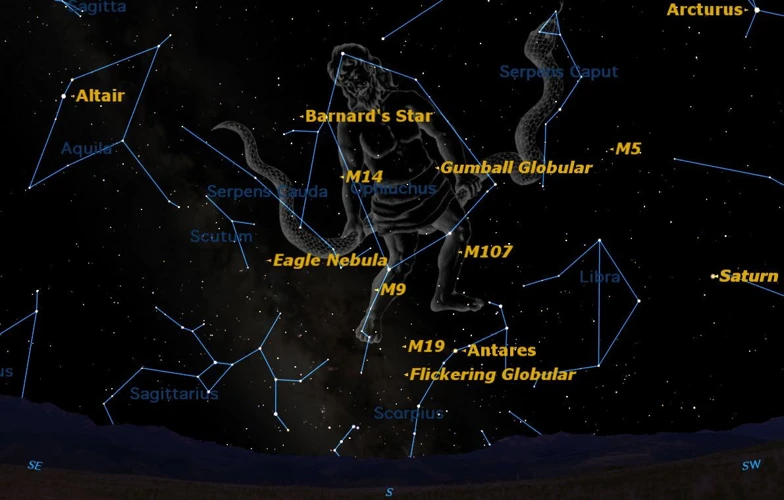
The Ophiuchus constellation is adorned with a plethora of intriguing and captivating features that make it a celestial wonder. One of its most prominent stars is Alpha Ophiuchi, also known as Rasalhague, which shines brightly as the serpent holder’s head. Another notable star in the constellation is Sabik, which forms the tail of the serpent. Ophiuchus is also home to the enigmatic Barnard’s Star, known for its high proper motion through the night sky. As we explore the depths of Ophiuchus, we encounter a host of nebulae and deep sky objects, including the Snake Nebula, the Dark Horse Nebula, and the iconic Pipe Nebula. Stargazers have the opportunity to observe fascinating double stars in Ophiuchus, such as Struve 2470 and 36 Ophiuchi. The constellation of Ophiuchus truly offers a feast for the eyes and an exploration of cosmic wonders.
The Serpent Holder: Alpha Ophiuchi
Alpha Ophiuchi, also known as Rasalhague, is one of the most prominent stars within the Ophiuchus constellation. With a visual magnitude of 2.08, it is easily visible to the naked eye. Rasalhague, derived from the Arabic phrase for “Head of the Snake Charmer,” aptly represents the serpent being held by Ophiuchus. This blue-white main-sequence star shines brightly in the night sky, captivating astronomers and stargazers alike. With a surface temperature of around 8,200 Kelvin, Rasalhague is approximately 47 light-years away from Earth. It is a binary star system, composed of a primary star and a smaller companion star. The primary star is larger and more massive, while the companion star is believed to be a red dwarf. Together, they orbit around a common center of mass. Rasalhague is not only an important celestial marker in the Ophiuchus constellation, but it also plays a significant role in ancient astronomy and celestial navigation. Its position and brightness have aided sailors and travelers throughout history, providing important reference points for navigation across vast oceans and lands. So, next time you gaze upon the night sky, take a moment to appreciate the majestic beauty of Alpha Ophiuchi, the serpent holder, and its enduring role in celestial navigation and ancient astronomy.
Herbal Remedies: Rasalhague and Sabik
Within the Ophiuchus constellation, two stars stand out for their connection to herbal remedies: Rasalhague and Sabik. Rasalhague, also known as Alpha Ophiuchi, is the brightest star in Ophiuchus and has long been associated with healing properties. In ancient times, it was believed that the light of Rasalhague could enhance the effectiveness of herbal remedies, leading to its reputation as a guiding star for medicinal purposes. Similarly, Sabik, another prominent star in Ophiuchus, has been linked to herbal medicine. Its name originates from an Arabic word meaning “the tester,” implying the star’s role in testing herbal remedies for their potency and efficacy. These two stars, with their historical connections to herbal remedies, add a unique dimension to the Ophiuchus constellation. Whether contemplating the influence of stars on earthly practices or simply appreciating their significance, Rasalhague and Sabik certainly enrich our understanding of the celestial world and its interplay with natural remedies.
The Enigmatic Barnard’s Star
Barnard’s Star, named after the American astronomer Edward Emerson Barnard, is one of the most intriguing stars in the Ophiuchus constellation. It holds a special place in astronomical history due to its proximity to our solar system. Located just over six light-years away, it is the fourth-closest known individual star to Earth (after the three stars in the Alpha Centauri system). Barnard’s Star is a red dwarf, with a relatively low mass and temperature compared to other stars. It has a faint apparent magnitude of 9.54, making it challenging to observe with the naked eye. However, it has captured the attention of scientists and space enthusiasts alike due to its high proper motion across the sky, making it the fastest-moving star as seen from Earth. This motion can be detected over a human lifetime, which is quite remarkable when considering the vast timescales involved in astronomical phenomena. Despite its proximity, Barnard’s Star has no confirmed exoplanets orbiting it, although it was once believed to have a potential candidate known as Barnard’s Star b. However, subsequent studies have disputed its existence. Currently, scientists continue to study this enigmatic star, hoping to unravel more of its secrets and understand its role within the vast cosmic tapestry. To learn more about the role of constellations in ancient astronomy and navigation, click on this link.
Nebulae and Deep Sky Objects
Nebulae and deep sky objects found within the Ophiuchus constellation offer stargazers a breathtaking visual feast. One notable feature is the Pipe Nebula, located near the border of Ophiuchus and the constellation of Scorpius. This dark nebula, resembling the shape of a smoking pipe, is a fascinating sight for observers equipped with a telescope. Another intriguing nebula is the Snake Nebula, officially known as Barnard 72. Situated close to the border with the constellation Sagittarius, this dark nebula appears like a curving snake winding through space. The abundance of these dark nebulae creates a vivid contrast against the backdrop of stars in the Ophiuchus region, making it an intriguing destination for astrophotography enthusiasts. Additionally, stargazers can explore the globular cluster M14, located on the outskirts of the constellation. With its dense concentration of stars, M14 presents a mesmerizing spectacle when viewed through a telescope. These magnificent nebulae and deep sky objects within Ophiuchus provide a treasure trove of celestial wonders, unveiling the captivating beauty of the cosmos. So, gear up your telescopes and let the exploration begin.
Notable Double Stars
In the vast expanses of the Ophiuchus constellation, astronomers have been fascinated by the presence of notable double stars. These celestial gems consist of two stars that appear to be close together, creating a stunning visual spectacle. One such double star is Gamma Ophiuchi, commonly known as Alnasl. Alnasl is located at the head of the serpent held by Ophiuchus and is easily spotted with the naked eye. It consists of two stars with contrasting colors; the primary star shines with a warm orange hue, while the secondary star displays a bluish-white radiance. This striking color contrast makes Alnasl a captivating sight in the night sky.
Another intriguing double star in Ophiuchus is Xi Ophiuchi, also known as Bode’s Nebula. Unlike many other double stars, Xi Ophiuchi consists of two young, hot stars that are so close together they share a common envelope of gas. This unique feature makes Xi Ophiuchi a fascinating subject for studies on stellar evolution and binary star systems.
Ophiuchus is home to the double star Epsilon Ophiuchi, also called Yed Posterior. Yed Posterior is a captivating pair of stars situated at the serpent’s body, offering a mesmerizing dance of light against the backdrop of the night sky. The primary star is a yellow giant, while the secondary star is a smaller, bluish companion. Observing Yed Posterior through a telescope allows astronomers to witness the intricate details of this stellar duo.
These notable double stars within the Ophiuchus constellation offer a glimpse into the vast diversity of stellar systems that exist in our universe. Their presence serves as a testament to the intricate nature of celestial objects and the wonders that await those who venture into the realms of the night sky. So, whether you are an experienced observer or a curious stargazer, make sure to take the time to explore and appreciate the awe-inspiring beauty of these remarkable double stars in Ophiuchus.
Observational Points for Stargazers
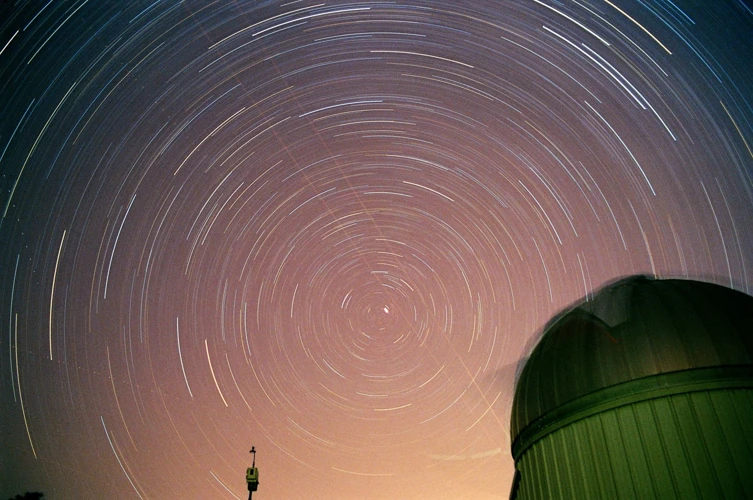
For stargazers eager to explore the wonders of the Ophiuchus constellation, understanding the best observational points is key. The optimal time to observe Ophiuchus is during the summer months in the Northern Hemisphere and during the winter months in the Southern Hemisphere. It is recommended to find a location with minimal light pollution, preferably away from cities and urban areas, to fully appreciate the celestial spectacle. Ophiuchus is positioned near the celestial equator, which allows for easy visibility from various latitudes. To locate this constellation, one can use prominent neighboring constellations such as Sagittarius and Scorpius as celestial markers. It is also beneficial to have a telescope or binoculars in order to observe the intricate details of Ophiuchus, including its double stars and nebulae. By employing these observational points and techniques, stargazers can embark on a cosmic journey and uncover the hidden treasures of the Ophiuchus constellation.
Best Time to Observe Ophiuchus
When it comes to observing Ophiuchus, timing plays a crucial role in getting the best views of this celestial wonder. The ideal time to observe Ophiuchus is during the summer months in the northern hemisphere and the winter months in the southern hemisphere. In the northern hemisphere, Ophiuchus rises above the southeastern horizon in the late evening during the months of May to July. This gives stargazers ample opportunity to witness its splendor throughout the night. On the other hand, in the southern hemisphere, Ophiuchus can be best seen in the early evening during the months of December to February. During these times, the constellation reaches its highest point in the sky, offering optimal visibility. It is important to choose nights with minimal light pollution and clear skies for the best viewing experience. Grab your telescope or binoculars, find a comfortable spot away from city lights, and prepare to be mesmerized by the celestial spectacle that is Ophiuchus. Whether you are a novice stargazer or an experienced astronomer, the best time to observe Ophiuchus is truly an awe-inspiring cosmic experience.
Location in the Celestial Sphere
To understand the location of the Ophiuchus constellation in the celestial sphere, we must familiarize ourselves with the concept of celestial coordinates. Similar to coordinates on Earth, celestial coordinates help us pinpoint objects in the night sky. The Ophiuchus constellation is located near the celestial equator, which is the projection of Earth’s equator onto the celestial sphere. It lies between the constellations of Sagittarius and Scorpius. In terms of right ascension, Ophiuchus spans approximately 16 hours, while in terms of declination, it ranges from around -10 degrees to +20 degrees. This means that Ophiuchus can be observed from both the Northern and Southern Hemispheres at different times of the year.
For observers in the Northern Hemisphere, Ophiuchus is best seen during the summer months when it appears higher in the sky. In contrast, observers in the Southern Hemisphere can spot Ophiuchus during the winter months. To locate Ophiuchus, one can look for its neighboring constellations. For example, finding the prominent constellation of Sagittarius can serve as a guide to spotting Ophiuchus. Additionally, star charts and mobile applications can be helpful tools in identifying the exact location of Ophiuchus in the night sky.
Understanding the location of a constellation in the celestial sphere is crucial for stargazers and astronomers to navigate the vast cosmos. By knowing the celestial coordinates of Ophiuchus, observers can plan their stargazing sessions and explore the wonders it has to offer. So, whether you’re in the Northern or Southern Hemisphere, take advantage of the optimal viewing times and explore the celestial beauty of the Ophiuchus constellation.
Equipment and Techniques for Observation
When it comes to observing the Ophiuchus constellation, having the right equipment and employing the correct techniques can greatly enhance your stargazing experience. To begin with, you will need a reliable telescope with a good aperture to capture the intricate details of the celestial objects within Ophiuchus. A telescope with at least an 8-inch aperture will provide a clear view of stars, nebulae, and other deep sky objects in the constellation. Additionally, using a telescope with a motorized mount will allow for smoother tracking of objects as they move across the night sky.
To further enhance your observation of Ophiuchus, consider using specialized filters. A narrowband filter, such as an H-alpha or OIII filter, can help isolate specific wavelengths of light emitted by nebulae, revealing intricate details that would otherwise be difficult to see. Using a low-light or nebula filter can help enhance the contrast and visibility of nebulae within the constellation.
In terms of techniques, the key to observing Ophiuchus lies in finding a dark sky location away from light pollution. The darker the sky, the more stars and deep sky objects within the constellation will be visible. Take the time to familiarize yourself with star charts or use planetarium software to locate specific objects of interest within Ophiuchus. This will help you navigate the constellation with ease and locate its various celestial wonders.
If you’re a beginner or prefer a more immersive experience, consider attending star parties or joining an astronomy club. These communities often offer access to experienced astronomers and advanced equipment, providing a valuable opportunity to learn from others and witness the wonders of Ophiuchus in collaboration.
So, grab your telescope, find a dark sky location, and embark on a celestial journey through the captivating Ophiuchus constellation. The combination of the right equipment, proper techniques, and a sense of wonder will undoubtedly make your observation of this intriguing constellation a truly memorable experience.
Mythological Connections and Cultural Significance
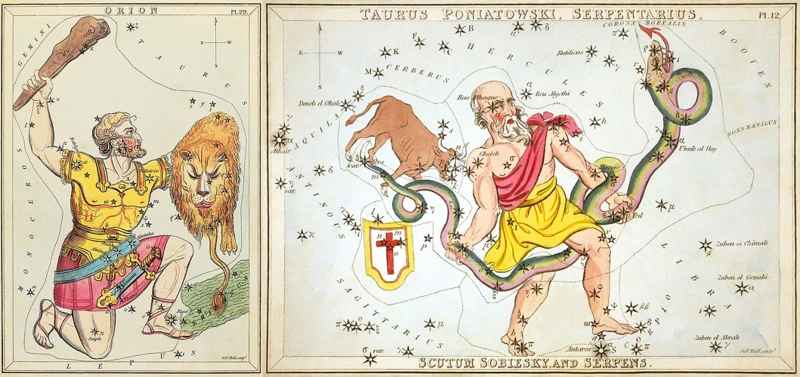
The Ophiuchus constellation has deep mythological connections and holds cultural significance in various societies. In Greek mythology, Ophiuchus is associated with the legendary healer Asclepius, son of Apollo, who possessed the power to resurrect the dead. Asclepius’s exceptional healing abilities angered Hades, the god of the underworld, resulting in Zeus striking him down with a lightning bolt and immortalizing him as the constellation Ophiuchus. This constellation also found its place in Roman mythology, where it was linked to Aesculapius, the Roman equivalent of Asclepius. In ancient Mesopotamia, Ophiuchus was associated with the god Enki, who represented knowledge and medicine. Culturally, Ophiuchus has significance in astrology as well. It introduced the controversial concept of a thirteenth zodiac sign, which intersects with astrology’s traditional twelve signs. While some astrologers embrace Ophiuchus as the “Serpent Bearer,” others adhere to the traditional zodiac signs. As we unravel the captivating stories and cultural connections surrounding the Ophiuchus constellation, we gain a deeper appreciation for its place in both ancient mythology and contemporary astrology.
Ophiuchus in Greek and Roman Mythology
In Greek and Roman mythology, Ophiuchus holds a significant place as the Serpent Bearer. The story behind this constellation revolves around the skillful healer Asclepius, who was the son of Apollo, the god of medicine and healing. Asclepius was known for his incredible knowledge of herbs and his ability to bring people back from the brink of death. His healing skills were so potent that Hades, the god of the underworld, became concerned that he would deplete the realms of the dead. As punishment for meddling with mortality, Zeus, the king of the gods, struck down Asclepius with a bolt of lightning. However, in recognition of his great healing abilities, Zeus raised Asclepius to the heavens as the constellation Ophiuchus. Ophiuchus is often depicted holding the serpent Serpens, which represents the two snakes used in Asclepius’ healing rituals. This mythological connection makes Ophiuchus a symbol of healing and medicine in both ancient Greek and Roman cultures. The prominence of Ophiuchus in mythology showcases the enduring impact of this constellation on human imagination and storytelling throughout history.
Astrological Significance and Controversies
The astrological significance of the Ophiuchus constellation has sparked quite a bit of controversy within the astrological community. Traditionally, the zodiac is composed of twelve signs, but the addition of Ophiuchus as the thirteenth sign has led to debates and disagreements. According to some astrologers, those born between November 29th and December 17th should be identified as Ophiuchus instead of their previously assigned zodiac sign. This shift has raised questions about the validity of astrology and the impact it has on individuals’ personalities and life paths.
Some astrologers argue that Ophiuchus should be incorporated into the zodiac due to its historical and cultural significance. They believe that this addition can bring a more accurate representation of the celestial bodies and their influence on human beings. However, critics contend that the inclusion of Ophiuchus disrupts the established system and undermines the foundations of traditional astrology.
Despite the controversy surrounding its astrological significance, Ophiuchus remains a captivating constellation that can be appreciated for its mythological origins and astronomical wonders. It is important to note that astrology and astronomy are distinct disciplines, with astrology focusing on personality traits and predictions while astronomy centers on the scientific study of celestial objects and their movements.
As we continue to explore the mysteries of the cosmos, the debate over Ophiuchus and its place in astrology will undoubtedly persist, leaving individuals to ponder the broader implications of zodiac signs and their influence on our lives. Whether one chooses to embrace the addition of Ophiuchus or stick to the traditional twelve zodiac signs, the fascination with astrology and its connections to human existence remains an enduring topic of interest.
The Future of Ophiuchus
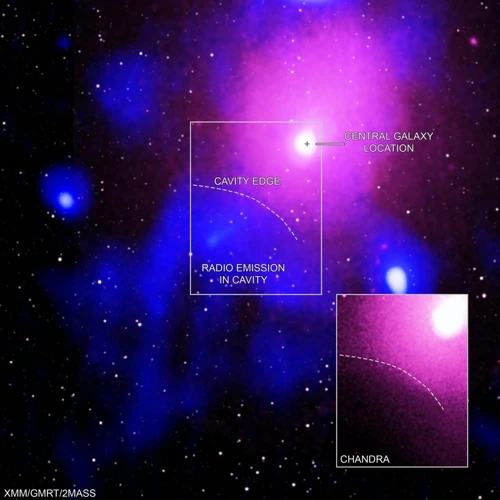
The future of the Ophiuchus constellation holds exciting prospects for astronomers and stargazers alike. As technology continues to advance, our understanding of this celestial region is set to deepen. Scientists and researchers are constantly discovering new stars, exoplanets, and other celestial phenomena within Ophiuchus, expanding our knowledge of the universe. With the development of more powerful telescopes and space exploration missions, we can expect to uncover even more about the mysteries that Ophiuchus holds. One area of interest is the search for exoplanets within this constellation. By studying the stars in Ophiuchus, scientists hope to identify habitable planets and explore the potential for extraterrestrial life. Additionally, the study of asteroids within Ophiuchus can provide valuable insights into the role of these celestial bodies in the evolution of the solar system and the Earth’s history. Understanding the composition and characteristics of these asteroids can shed light on the formation and development of our planet. As we continue to unravel the secrets of Ophiuchus, its significance in the fields of astronomy and planetary science will undoubtedly grow. So, keep your eyes on the skies and stay tuned for the exciting discoveries that await us in the future of the Ophiuchus constellation.
Conclusion

In conclusion, the Ophiuchus constellation offers a myriad of wonders for stargazers, astronomers, and enthusiasts alike. Its enthralling mythology, positioning in the night sky, and distinctive stellar features make it an intriguing subject of study. The Ophiuchus constellation provides a wealth of opportunities for observation, with its prominent stars, nebulae, and deep sky objects showcasing the beauty of the cosmos. Exploring this celestial region can be a profound experience, connecting us to ancient mythology and expanding our understanding of the universe. Whether you are a seasoned astronomer or a novice stargazer, Ophiuchus invites you to explore its mysteries and delve into its cultural significance. So, grab your telescope, venture into the night, and embark on a celestial journey to uncover the secrets of the intriguing Ophiuchus constellation. And while you’re here, don’t forget to check out other captivating topics like the role of asteroids in evolution or astrological relationship compatibility between Pisces and Virgo to expand your cosmic knowledge. The universe awaits!
Frequently Asked Questions

What does Ophiuchus represent in mythology?
Ophiuchus represents a healer in mythology, often depicted as a man grasping a serpent. The constellation symbolizes the pursuit of knowledge, wisdom, and medicinal practices.
When is the best time to observe Ophiuchus?
The best time to observe Ophiuchus is during the summer months in the northern hemisphere and during winter in the southern hemisphere. It is visible in the evening sky and reaches its highest point around midnight.
Are there any notable double stars in Ophiuchus?
Yes, there are notable double stars in Ophiuchus. Some examples include 70 Ophiuchi and 36 Ophiuchi. These double stars provide interesting observations and opportunities for scientific study.
What are some deep sky objects in Ophiuchus?
Ophiuchus is home to several deep sky objects, including the famous Barnard’s Star, a red dwarf that is relatively close to our solar system. Other notable objects include the Rho Ophiuchi Complex, a beautiful region of star formation, and the globular cluster M14.
Is Ophiuchus part of the zodiac?
While Ophiuchus is not traditionally a part of the zodiac, it has gained attention in recent years as a proposed 13th zodiac sign. However, its inclusion remains controversial and is not widely accepted in mainstream astrology.
How can I locate Ophiuchus in the night sky?
To locate Ophiuchus, start by finding the bright star Antares in the constellation Scorpius. Ophiuchus is located above and to the left of Antares. It is also helpful to use a star chart or smartphone app to navigate and identify the constellation.
What equipment do I need to observe Ophiuchus?
To observe Ophiuchus, you will need a telescope or binoculars, preferably with a good field of view. A star chart or smartphone app can also be helpful for identifying and locating specific stars and objects within the constellation.
What is the mythological connection of Ophiuchus to Greek and Roman culture?
In Greek and Roman mythology, Ophiuchus is associated with the healer Asclepius. Asclepius was known for his exceptional medical skills and was revered as a god of healing and medicine.
Can I see Ophiuchus from both hemispheres?
Yes, Ophiuchus is visible from both the northern and southern hemispheres. However, its position in the night sky and visibility may vary depending on the viewer’s location and the time of year.
Is Ophiuchus linked to any astrological relationship compatibility?
Ophiuchus is not traditionally linked to astrological relationship compatibility. However, some enthusiasts believe that individuals born under Ophiuchus may exhibit unique personality traits and can align well with certain zodiac signs.
References
Frequently Asked Questions

1. Can Ophiuchus be seen with the naked eye?
Yes, Ophiuchus is one of the few constellations that can be seen with the naked eye. It is visible from both the Northern and Southern Hemispheres.
2. What is the best time to observe Ophiuchus?
The best time to observe Ophiuchus is during the summer months in the Northern Hemisphere. It is highest in the sky during the months of July and August.
3. How can I locate Ophiuchus in the night sky?
Ophiuchus can be located by finding the prominent constellation Scorpius and then looking just west of it. The head of Ophiuchus is also marked by the bright star Rasalhague.
4. What are the major stars in the Ophiuchus constellation?
Some of the major stars in Ophiuchus include Alpha Ophiuchi, Rasalhague, and Sabik. These stars are known for their brightness and significance in celestial navigation.
5. Can I observe nebulae and deep sky objects in Ophiuchus?
Absolutely! Ophiuchus is home to several notable nebulae and deep sky objects, including the Snake Nebula, the Barnard’s Star, and the Ophiuchus Cluster. These objects can be observed with a telescope.
6. What is the mythology behind the Ophiuchus constellation?
In Greek mythology, Ophiuchus is associated with the legendary healer Asclepius. It is said that he was able to resurrect the dead using his knowledge of medicinal herbs. This led to his placement in the heavens as a constellation.
7. How is Ophiuchus connected to astrology?
While Ophiuchus is not officially recognized as one of the 12 zodiac signs, there is a controversial belief that it should be included. Those born between November 29 and December 17 are said to have Ophiuchus as their zodiac sign.
8. Are there any notable double stars in Ophiuchus?
Yes, Ophiuchus is home to several interesting double stars, such as 70 Ophiuchi and 36 Ophiuchi. These binary star systems offer captivating views for stargazers.
9. What equipment do I need to observe Ophiuchus?
To observe Ophiuchus, a telescope is recommended for a closer look at the nebulae and deep sky objects. Additionally, a star chart or a stargazing app can be helpful in locating the constellation.
10. Is there any cultural significance associated with Ophiuchus?
Ophiuchus holds cultural significance in various ancient civilizations. It is featured in the mythology of Greece, Rome, and other cultures, often representing medicine, healing, and the power of knowledge.







